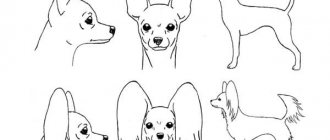Pomeranians are ideal pets for city dwellers with their tiny size and sweet personality.
They are best known for their lively personalities and adorable fluffy coats. However, did you know that the Pomeranian's fluffy double coat can come in over 10 different colors?
There are actually 13 different Pomeranian colors, ranging from pale cream to merle. Perhaps you'll fall in love with their famous orange coat, or maybe you'll love the rare tiger pattern?
Pomeranian Spitz color chart
There are 13 different colors of the Pomeranian recognized by the World Kennel Club.
Some colors, such as beaver and brindle, are less common than the more traditional red, orange, white and black. You can see a complete list of all coat colors in the table below:
| Color | Appearance | Popularity rating |
| orange | Bright orange without black markings. Gradient from light to dark orange. | 1 |
| red | A deep rusty red color with lighter cream fur on the chest. | 2 |
| white | Pure white with no cream or darker markings. | 3 |
| black | Solid black color. | 4 |
| Merle | Splashes of red on a brown base with splashes of white. | 5 |
| Wolf sable | Gray fur with black nose, eye rims, lips and paw pads. | 6 |
| Chocolate | Colors from milk to dark chocolate. | 7 |
| Blue | Silver-gray and dark gray guard hairs. | 8 |
| Cream | Pale fur that looks like a honeycomb. | 9 |
| brindle | With streaks of red, gold, orange and black. | 10 |
| Black and Tan | Fluffy, with black fur on the face and back, with tan on the chest and legs. | 11 |
| Beaver | Light brown in color, reminiscent of a pale cookie. | 12 |
| Tricolor | Black, brown and white pattern. | 13 |
Spitz color chart
Breed traits
Breed traits (on a 5-point scale)
| Keeshond (Dutch Wolf Spitz) | |||
| Activity | in the house | 2.4 | |
| on the street | 3.2 | ||
| Obedience | training | 4.1 | |
| strangers | 3.8 | ||
| Domination | in family | 1.7 | |
| over dogs | 2.1 | ||
| Defending your territory | from people | 1.9 | |
| from dogs | 2.2 | ||
| Sociability | in family | 4.8 | |
| with strangers | 4 | ||
| with dogs | 3.4 | ||
| Concentration | in family | 1.2 | |
| in front of strangers | 1.6 | ||
| with dogs | 2 | ||
| Aggressiveness | in family | 1 | |
| to strangers | 1.4 | ||
| to the dogs | 1.9 | ||
| to cats | 1.5 | ||
| Family behavior | calmness | 4.8 | |
| demand for affection | 4.7 | ||
| excitability | 3.9 | ||
| playfulness | 3.8 | ||
| excessive barking | 3.1 | ||
| behavioral breakdowns | 1.8 | ||
| Tolerance for children | up to 4 years | 4 | |
| over 4 years old | 4.4 | ||
| Institutional use | watchman | 4.5 | |
| bodyguard | 1.7 | ||
This breed is often compared to the following dog breeds: Samoyed, Cavalier King Charles Spaniel, Shiba Inu, Miniature Schnauzer, Pekingese.
Photos of Keeshonds:
Pomeranian Spitz
© shutterstock
When dog lovers think of this breed, they think of orange. Breeders call the orange Pomeranian clear orange to distinguish this color from the orange sable. This color was developed by crossing an orange Pomeranian with a sable carrying a pure recessive gene.
These Pomeranians are often puppy-pale. It's a pleasure to watch them ripen and see their color change from pale creamy white to bright orange. Sometimes these puppies' sable coats also turn bright orange.
They typically lack black fur and are a lighter cream color with a gradient of light to dark orange. Orange Pomeranians are very easy to find and are recognized as an acceptable color in their breed standard.
Health
Purebred Keeshonds are distinguished by good health and a long life span. This is due to the natural origin of the breed and the long history of its formation.
You can understand what hereditary diseases your pet may develop in the future by looking at the health of the Wolfspitz’s parents. A conscientious breeder will always provide such information about the ancestors of a Keeshond puppy. In old age, the Wolf Spitz is at greater risk of having a malfunction of the endocrine system. Poor diet and improper exercise can lead to the development of heart disease.
Proper prevention and regular check-ups with a veterinarian will help keep your pet healthy.
Diseases
During the development of the breed, the German Spitz acquired an increased risk of developing certain diseases:
- dysplasia and joint dislocations;
- diabetes;
- obesity;
- retinal atrophy;
- cataract;
- epilepsy;
- allergic dermatitis;
- hypothyroidism
In addition, the Keeshond Spitz is prone to Von Willebrand's, Cushing's and Addison's diseases.
Vaccinations
Despite its good immunity, the Keeshond dog breed needs regular vaccinations. The first vaccinations are usually given by the breeder before the puppy goes to its new home.
At the age of 3 weeks, the dog receives anti-helminth medications, which are given again after 1.5-2 weeks. If the baby is healthy, after 10 days you can vaccinate your Wolfspitz against dangerous viruses and infections.
All Keeshond puppies must be vaccinated against:
- plague;
- rabies;
- hepatitis A;
- parainfluenza;
- parvovirus;
- leptospirosis.
Repeated vaccinations and dewormings are carried out annually according to the schedule established by the veterinarian.
Red Pomeranian Spitz
© shutterstock
The coat of a red Pomeranian is a dark red rusty hue with lighter cream fur on the chest. It is often confused with the subtler orange.
Red is one of the many colors that can be displayed in a ring. From a genetic point of view, they are similar to black Pomeranians because both colors belong to the E locus gene.
Red and orange are one of the two most popular colors.
Spotted
Another interesting color option is spotted. Color spots appear evenly across the base color. They can be black, red or gray. A dog with these inclusions on the undercoat is not one of the common variants. To purchase it, you will need to look for a puppy with this color. However, he will stand out noticeably against the background of dogs with “bored” coat colors.
In general, no matter what shade of coat you personally like (“sable”, gray or “orange”), such a dog will certainly become a member of your family. She is cheerful, active and incredibly playful, so she will appeal to both adults and children. Choose a puppy with the color you like and get a real four-legged friend.
Similar article: How to properly prepare for estrus and mating of Spitz dogs
White Spitz
© shutterstock
White Pomeranians are pure white with no cream or dark markings.
If you like the look of the Samoyed but want a smaller breed, then this white dog is perfect!
They are born white as puppies and remain this color throughout their lives.
White oranges are white due to the lack of pigment. They do not have the dark pigment melanin (i.e. black eumelanin) that dogs typically have. Due to a lack of pigment, albino animals have red eyes or pink noses. However, a white Spitz is not an albino because its eyes and nose are black.
This adorable Cloud Dog is perfect for anyone who dreams of owning a furry pet and requires the same care, exercise and nutrition as any other color Pomeranian.
Contents and rules of care
Many people think that the breed requires long and complex daily care. Despite the luxurious fur, it needs to be given a maximum of half an hour a day. It is enough to comb the fur coat several times so that tangles do not form and the dog looks neat.
As for bathing, the breed is not picky about this, and no more than 6 sessions will be required per year. Of course, more washing is allowed, but only if absolutely necessary. During the rainy season, when a dog comes back from a walk, he looks more like a lump of dirt than a beautiful pet. To take baths you will need a specialized shampoo.
Teeth brushing is necessary every day, ears - once a week. Trim nails as they grow. This is such a simple, but mandatory care.
Speaking about the content, I would like to note that the cream Spitz is not a yard dog. The breed was created for home warmth and comfort; the pet needs its own place to rest and toys. The last point is mandatory; without personal attributes, the Pomeranian Spitz will begin to chew on everything.
Black Pomeranian Spitz
© shutterstock
This Pomeranian is an adorable solid black color.
Known by fans as creatures of darkness, they still have the signature feisty spirit that we love about the breed.
The black color is created by the E Locus allele gene, which increases the production of black pigment and results in a solid black Pomeranian.
Be careful when taking your black Pomeranian outdoors, as the sun will gradually discolor their fur and result in a reddish-brown coat.
This color is perfect for those who like to wear black clothes as the fur that falls out will remain hidden!
Breeding Spitz dogs by color or how to avoid marriage
Breeders cannot always say exactly what color an adult pet will be . Therefore, if you want to seriously engage in Spitz breeding, you need to more carefully study the pedigree of the parents and their ancestors, taking into account what shades were found in this genetic branch.
You will need to be patient and painstaking, since in some countries breeders do not indicate the color of the parents in the pedigree and metrics. Or there are differences in the names of colors in different countries, for example, the American names of colors differ from European ones.
Quite often you can tell what color an animal will grow up by looking at the color of the fur behind its ears, but this is not an exact guarantee. But, if you are taking a puppy for a family, then you will agree that it will not be so important for you if the puppy’s color changes. After all, after the first hours of your baby’s stay at home, you will fall in love with him forever, not paying attention to the shade of his fur.
Spitz merle
© shutterstock
Merle is a beautiful color pattern because the fluffiness of the Pomeranian's coat shows splashes of red on a brown base with splashes of white. This coloration is very similar to the Australian Cattle Dog. They are often seen as blue or red merles.
Their nose and paws are often variegated shades of pink and black, and their eye color can range from dark brown to blue.
This specimen was bred by mating a merle parent to a black or chocolate Pomeranian.
Make sure your breeder understands the risks associated with breeding Merle dogs. The Double Merle can be very susceptible to deafness or blindness. This is because the double merle gene suppresses certain pigment cells in the iris and cochlea.
This color will wow everyone at the dog park and is perfect for those looking for a splash of color on their pet.
Spitz sable color
© shutterstock
The wolf sable Pomeranian is sometimes called the gray sable because it looks very similar to the gray but has black-tipped guard hairs.
This gray variety has a sable pattern, which gives them a black nose, eye rims, lips, and paw pads.
The darkest parts are often the face, back and chest.
Wolf sable is one of the rarest Pomeranian colors and many are mistaken for orange sable. Finding a purebred Wolf Sable Spitz is incredibly difficult, even though the first one was shown in 1901.
The only way to be sure your puppy is a Sable wolf is to take a color gene test.
Chocolate Pomeranian
© shutterstock
Chocolate Pomeranians can range in color from milk to dark chocolate, and their nose and paw pads are often the same silky brown color.
The chocolate color is caused by the B Locus gene, which creates a black pigment that darkens a dog's coat. The mutation dilutes this pigment and results in a chocolate-colored coat.
Like many dogs with darker coats, they do best when not exposed to direct sunlight for long periods of time. Sunlight will redden the coat and make it harder to see the chocolate color.
This dog is a great choice for any owner who wants to walk a teddy bear.
Blue Spitz
© shutterstock
This Pomeranian is born silver-gray and has dark gray guard hair with a blue undercoat.
Blue is a color recognized by the American Kennel Club and is easy to admire.
Blues are bred from two solid-colored parents who carry a diluted gene.
There are health concerns associated with any blue dog because they have a chance of hair loss caused by dilution of the color, leading to hair loss and dry skin.
A blue Pomeranian purchased from a reputable breeder will make a wonderful companion.
Cream Pomeranian
© shutterstock
The Cream Spitz is a beautiful dog with light fur. This cream-colored dog is often born white, but after a few months its coat darkens to cream.
One of the genes involved in creating the cream color is the E Locus gene, which also gives the red Pomeranian color.
This color variety requires careful grooming as their fur shows up easily on clothing.
Feeding
It is ideal to feed your Spitz a balanced dry food, which can be alternated with soft canned dog food. You should not constantly feed your baby the same formula (only premium, one manufacturer, one composition), otherwise digestive problems and allergies may arise. If there is a need to switch to another type of food or natural food, then do it gradually.
When feeding your dog natural food, it is worth remembering that not everything is healthy that your pet really likes. You cannot treat your dog from your table; you need to cook for it separately. The diet should contain at least 40% meat ingredients (pulp, minced bones, offal), the rest - cereals, vegetables, fruits. You should not give sweets, salty and smoked (also fried) foods even for the purpose of enjoying them.
When feeding natural food, do not forget about the need to supplement the diet with a mineral and vitamin complex. Auxiliary vitamins will not be required when eating a diet with specialized dry food.
brindle spitz
Brindle pattern dogs have stripes of red, gold, orange and black.
The Pomeranian's long coat serves as a canvas for layers of earthy tones.
Brindle is more of a pattern than a color and results in dark stripes. The darkest spots are usually the paws, ears, muzzle and back.
Some are more gray in color and some are brown.
The brindle pattern is caused by the recessive "EE" E Locus genotype.
Each brindle color is different, so you can be sure to get a unique dog.
Price
Animals with a dominant genome are quite valuable for breeding and are therefore expensive.
Puppy
The average cost of a show class black Spitz puppy starts from 50 thousand rubles, pet class - from 30 thousand rubles.
Nurseries
“Min Herts” - Russia, Kashira; “Nixend” - Russia, Moscow; “Bis Grünen Hof” - Russia, Chelyabinsk; Danube Dwarf Country - Serbia, Belgrade; “Lovely Tail Axi” – Russia.
Black and tan Spitz
© shutterstock
The Black and Tan Pomeranian is a color variety with a black and tan pattern. They are fluffy, with black fur on the face and back, and tan on the chest and legs.
Light brown highlights highlight the breed's characteristic pointed eyebrows and give them a sweet and charming appearance. Many have adorable dotted markings above their eyes that resemble eyebrows.
Charming and sassy is the best way to describe this color.
They are very similar in genetics to sable Pomeranians, as they share the same recessive allele.
Black and Tan Pomeranians are unique and look similar to the smaller Rottweiler or Doberman Pinscher.
Anyone who loves the appearance of these breeds but prefers to have a dog that is suitable for apartment living will be delighted with this dog.











